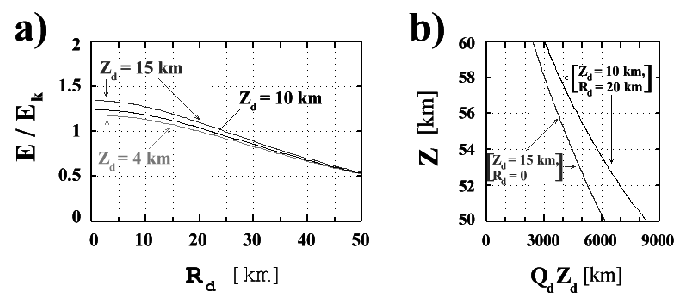It has been estimated that a parent discharge charge moment change of
8000 C![]() km would be required to initiate a daytime sprite at
50 km altitude (Fernsler and Rowland, 1996). In order to better assess
the possibility of conventional breakdown onset as a function of
charge height and horizontal extent parameters, the parent discharge
is modeled as a uniformly charged disk of radius
km would be required to initiate a daytime sprite at
50 km altitude (Fernsler and Rowland, 1996). In order to better assess
the possibility of conventional breakdown onset as a function of
charge height and horizontal extent parameters, the parent discharge
is modeled as a uniformly charged disk of radius ![]() , height
, height ![]() ,
and total charge
,
and total charge ![]() . This static field approximation is nearly
identical to that used in Section 2.5.2 for nighttime
calculations, with the main difference here being that the base of the
ionosphere is approximated as 62 km altitude (where
. This static field approximation is nearly
identical to that used in Section 2.5.2 for nighttime
calculations, with the main difference here being that the base of the
ionosphere is approximated as 62 km altitude (where
![]() ms) instead of 81 km.
ms) instead of 81 km.
Figure 4.7a shows that conventional breakdown
(
![]() ) probably would have occurred at 54 km
altitude (where
) probably would have occurred at 54 km
altitude (where
![]() for profile A of
Figure 4.6b) for
for profile A of
Figure 4.6b) for
![]() = 6000 C
= 6000 C![]() km (ie, the first sprite-producing
discharge) if
km (ie, the first sprite-producing
discharge) if ![]() 25 km. Table 3.1 shows that
25 km. Table 3.1 shows that
![]() is typically
is typically ![]() km for nighttime sprite-producing +CGs,
which supports the possibility that the radius of even this unusually
energetic flash might have been small enough to produce conventional
breakdown for Profile A. However, it is clear from
Figure 4.7b that the first sprite-producing
discharge would probably not have been able to initiate conventional
breakdown at altitudes where
km for nighttime sprite-producing +CGs,
which supports the possibility that the radius of even this unusually
energetic flash might have been small enough to produce conventional
breakdown for Profile A. However, it is clear from
Figure 4.7b that the first sprite-producing
discharge would probably not have been able to initiate conventional
breakdown at altitudes where
![]() in Profile B.
in Profile B.
 |
The charge moment changes at the onset of the second and third sprite
field changes was shown to be 4300 C![]() km and 3900 C
km and 3900 C![]() km,
which would have been insufficient to initiate conventional breakdown
at 54 km according to Figure 4.7b. One speculative
possibility is that the conductivity above 54 km altitude had somehow
been decreased by the energetic first sprite event on the time scale
of minutes, leading to a higher initiation altitude and hence lower
initiation threshold.
km,
which would have been insufficient to initiate conventional breakdown
at 54 km according to Figure 4.7b. One speculative
possibility is that the conductivity above 54 km altitude had somehow
been decreased by the energetic first sprite event on the time scale
of minutes, leading to a higher initiation altitude and hence lower
initiation threshold.